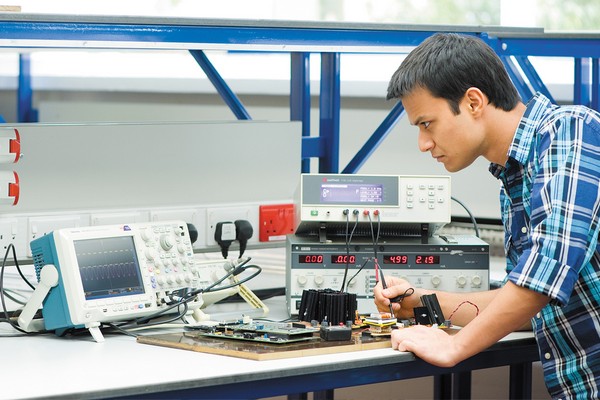Arya Madar Arjomand Company is considered one of the top actors in the field of electricity and electronics in the country, so we felt it necessary to learn more about this field of study and work in this section of the website. Before entering into the discussion in detail, we recommend that you visit the page
about Arya Madar Arjomand company to learn more about Arya Madar Arjomand's business, which is focused on
circuit design and board manufacturing.
Electronic Engineering
Electrical and electronic engineering is a branch of engineering that deals with the practical applications of electricity in all its forms, including in the field of electronics. Electronic engineering is a branch of electrical engineering that deals with topics such as electromagnetic spectrum and the application of electronic devices such as integrated circuits and transistors.
In engineering practice, the distinction between electrical and electronic engineering is usually based on the relative strength of the electrical currents used. In this sense, electrical engineering is the branch that deals with "heavy current" or in other words electric light and power systems and devices, while electronic engineering deals with "light current" applications such as telephone and radio communications, computers, radar, and automation. Of course, it should be noted that the distinction between disciplines has decreased with technical progress and the expansion of the global community. For example, in high-voltage power transmission, large arrays of electronic devices are used to convert transmission line current at power levels of tens of megawatts. In addition, in the regulation and control of interconnected power systems, electronic computers are used to calculate needs with much more speed and accuracy than manual methods, with this account, electricity and electronics are always complementary to each other.
Electronic engineering or electronics engineering is a form of engineering that deals with electronic circuits, devices and equipment and the systems that use them.
Many people are working in the field of electronic engineering and they find their jobs very attractive and the challenges they face are interesting, so if you are interested in entering the market of studying or working in this field, you should know You will not deal with easy science. From our point of view, everything in electronic engineering is the science of creativity. The whole field of engineering is concerned with designing, building, implementing and serving things that people need to be designed and built in the best possible way.

Electrical and electronic engineering trends
The largest branch of electrical engineering, computer electronics, was introduced during World War II. The field of computer science and engineering has attracted members of many disciplines outside of electronics, especially logicians, linguists, and applied mathematicians.
Another very big field is related to light and electricity and their applications. The specializations of this field include the design, manufacture and use of turbines, generators, transmission lines, transformers, motors, lighting systems and household appliances and such issues. In Iran, if we want to count the branches of electrical engineering based on university standards, they are described as follows:
The trend of electrical energy systems
Electronics orientation,
control orientation,
telecommunications orientation,
digital systems orientation,
bioelectricity orientation
With the expansion of universities and private organizations, if you consider another trend necessary to be mentioned in this section, please share it with us in the comments section, and if you have studied in these fields, state that you are satisfied with the job market . are you or not
<p

History of electricity and electronics
We will have a brief look at the history and background of electricity and electronics and the engineering field related to it. Electrical phenomena attracted the attention of European thinkers in the early 17th century. The most prominent pioneers include Ludwig Wilhelm Gilbert and Georg Simon Ohm from Germany, Hans Christian Orsted from Denmark, Andre Marie Ampere from France, Alessandro Volta from Italy, Joseph Henry from the United States and Michael Faraday from England. Electrical engineering as a discipline may be said to have emerged in 1864 when Scottish physicist James Clerk Maxwell summarized the fundamental laws of electricity in mathematical form and showed that electromagnetic energy radiation travels through space at the speed of light. Thus, light itself was shown to be an electromagnetic wave, and Maxwell predicted that such waves could be produced artificially. In 1887, German physicist Heinrich Hertz put Maxwell's prediction into practice by experimentally producing radio waves.
The first practical application of electricity was the telegraph, which was made by Samuel Morse in 1837. Other important events include the invention of the telephone (1876) by Alexander Graham Bell and the incandescent light bulb (1878) by Thomas Edison. These devices and Edison's first Central Generating Station, in New York City (1882), created a great demand for the employment of people trained to work with electricity.
The discovery of thermionic emission or "Edison effect" was the first observation of current in space. Hendrik Anton Lorentz from Holland expressed the theory of electron electric charge in 1892 and in 1897 J. Thomson showed England that thermionic emission is actually caused by negatively charged particles (electrons). This led to the work of Guglielmo Marconi of Italy, Lee de Forest of the United States, and many others who laid the foundations of radio engineering. In 1930, the term electronics was introduced for the use of radio and industrial applications of electron tubes. Since 1947, when the transistor was invented by John Bardeen, Walter H. Invented by Brattin and William B. Shockley, electronic engineering became dominated by the use of solid-state electronic devices such as transistors, semiconductor diodes, and integrated circuits.
You can get more complete information in this area to the page Electronic knowledge refer to
